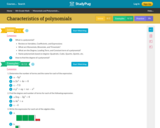
This site contains activities that will help students learn concepts dealing with expressions, equations, and the coordinate plane.
- Subject:
- Mathematics
- Material Type:
- Lesson Plan
- Date Added:
- 12/01/2023

This site contains activities that will help students learn concepts dealing with expressions, equations, and the coordinate plane.

This site consists of interactive lessons on a multitude of math topics including sets, drawing plane and coordinate system, variables, equations, and functions. You may also view this Vienna University site in German.

This lesson explains what the meaning is of two lines intersecting one another in the coordinate plane. [2:24]

Solve a word problem with Mike and Padhu. This video focuses on valid methods of problem solving, including guess-and-check and modeling with manipulatives.

Jessica explains more important things you should know about using variables. [3:33]
Khan Academy learning modules include a Community space where users can ask questions and seek help from community members. Educators should consult with their Technology administrators to determine the use of Khan Academy learning modules in their classroom. Please review materials from external sites before sharing with students.

(Nota: Esta es una traducción de un recurso educativo abierto creado por el Departamento de Educación del Estado de Nueva York (NYSED) como parte del proyecto "EngageNY" en 2013. Aunque el recurso real fue traducido por personas, la siguiente descripción se tradujo del inglés original usando Google Translate para ayudar a los usuarios potenciales a decidir si se adapta a sus necesidades y puede contener errores gramaticales o lingüísticos. La descripción original en inglés también se proporciona a continuación.)
En el módulo 4, los estudiantes extienden lo que ya saben sobre las tarifas unitarias y las relaciones proporcionales con ecuaciones lineales y sus gráficos. Los estudiantes entienden las conexiones entre relaciones proporcionales, líneas y ecuaciones lineales en este módulo. Los estudiantes aprenden a aplicar las habilidades que adquirieron en los grados 6 y 7, con respecto a la notación simbólica y las propiedades de la igualdad para transcribir y resolver ecuaciones en una variable y luego en dos variables.
Encuentre el resto de los recursos matemáticos de Engageny en https://archive.org/details/engageny-mathematics.
English Description:
In Module 4, students extend what they already know about unit rates and proportional relationships to linear equations and their graphs. Students understand the connections between proportional relationships, lines, and linear equations in this module. Students learn to apply the skills they acquired in Grades 6 and 7, with respect to symbolic notation and properties of equality to transcribe and solve equations in one variable and then in two variables.
Find the rest of the EngageNY Mathematics resources at https://archive.org/details/engageny-mathematics.

In this lesson on evaluating expressions, students will learn how to evaluate expressions for given values using the order of operations.

Given a, b, and c shown on the number line, Sal determines if statements like -b < c are true. [4:54]
Khan Academy learning modules include a Community space where users can ask questions and seek help from community members. Educators should consult with their Technology administrators to determine the use of Khan Academy learning modules in their classroom. Please review materials from external sites before sharing with students.

This activity is an experimental investigation in which students use paper helicopters to examine types of variables and how to manipulate variables in experimental design.

What do plants need? Students examine the effects of light and air on green plants, learning the processes of photosynthesis and transpiration. Student teams plant seeds, placing some in sunlight and others in darkness. They make predictions about the outcomes and record ongoing observations of the condition of the stems, leaves and roots. Then, several healthy plants are placed in glass jars with lids overnight. Condensation forms, illustrating the process of transpiration, or the release of moisture to the atmosphere by plants.

Equilateral triangles are explored in this learning tutorial, which includes several videos [4:18; 4:18; 3:18] and a PowerPoint presentation. The lesson includes an introduction of equilateral triangles and their key characteristics. Demonstrations are provided that solve problems involving area and angle measurements.

In this video, students take a quick trip through the history of drive-in theaters and are then asked to consider the question, "What is the relationship between the size of an object's shadow and the object's distance from a light source?" In the accompanying classroom activity, students do a hands-on experiment about the size of their own shadows at different distances from a projector or other light source.

This pathway introduces the scientific method as the fundamental concept of the scientific process and illustrates how scientific inquiry should be conducted.

A polynomial consists of constants, variables, and exponents. Polynomials are named based on the number of terms they have. Watch this brief video introducing polynomials. [0:47]

The domain of a function is all the possible values of x's of ordered pairs; whereas the range of a function is all the possible values of y's of ordered pairs. You can easily find them by graphing the functions or ordered pairs. Let's see how in this lesson. Includes a video tutorial, examples, and practice problems.

In this lesson, you will learn how to solve linear inequalities as well as how to graph the solutions on number lines and the XY plane. [8:22]

You will learn how to solve multi-step linear inequalities in this lesson. Besides typical math questions, you are going to see word problems related to multi-step linear inequalities and money. [8:15]

Determine how many valentines will be exchanged depending on the number of students in each class. This interactive exercise focuses on examining data to find a pattern and extending the pattern until a rule can be realized, taking math out of the classroom and into the real world.

Find a quick, concise explanation of what variables are. An example is given and clearly explained.

Watch this video tutorial to see step-by-step instructions on how to add polynomials of any size by grouping like terms and then combining them together. [5:00]